
History's Innovative Autos
Ever since automobiles hit the market in the late 19th
century, carmakers have vied to design the vehicle that would
change personal transportation forever. Now, in the face of
rising fuel costs and concerns about the environment,
consumers and governments are also calling for change.
Ironically, some of the technologies that could help drive the
car of the future have been around for a century. In this
slide show, explore nine automotive innovations—some
promising and some perilous—that arose from the fertile
minds of early engineers.—Rima Chaddha
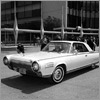

|
|
Jet engines
During World War II, automotive companies inspired by
advances in jet engines tried to adapt the technology
for use in cars. Chrysler's so-called Turbine Car (left)
used a rotary fan, propelled by rapidly burning fuel, to
drive the vehicle. By 1963, such experimental turbine
engines could run on gasoline, jet fuel, or even
vegetable oil, and like actual jet engines, they
provided powerful acceleration. But they also suffered
from significant problems, among them high fuel
consumption. Rover's Jet-1, for instance, traveled just
six miles per gallon.
|
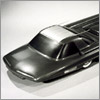

|
|
Nuclear propulsion
The Ford Nucleon concept car symbolized the 1950s Atomic
Age, when nuclear energy seemed to offer a clean
alternative to traditional fuels. Engineers proposed
that the Nucleon (left) would be powered by a small
nuclear reactor, which would split atoms to release
energy in the form of heat. The heat would convert
stored water into steam, and the steam would propel
turbine fans to drive the engine. But the envisioned
pint-sized reactors Ford was counting on to be developed
did not materialize, even as recognition of the inherent
danger did. In the end, no working prototypes were
built.
|
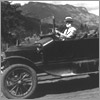

|
|
Steam
Steam cars were in vogue by the late 19th century. Of
these, the Stanley Steamer (left), produced from 1896 to
1924, was the most popular, often outselling
conventional gas-powered cars. It even reached a
record-breaking 127 mph in 1906. The Steamer burned
gasoline or kerosene to heat water in a boiler; the
boiling water then generated steam, and pressure from
the steam powered the engine. Their price tag doomed
steam cars by the start of the Great Depression,
however. Steamers cost thousands of dollars apiece,
compared to Ford's Model T, which sold for less than
$500.
|
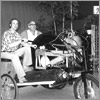

|
|
Compressed air
In 1979, as America found itself embroiled in an energy
crisis, Missouri-based engine designer Terry Miller
built a car that ran on an abundant, zero-emission fuel
source—air. Compressed-air engines had been used
in some locomotives and trucks since the 1800s, but
Miller streamlined the design for his Air Car One
(left). Pressure generated by the release of compressed
air from onboard tanks drove the car's engine. Miller's
vehicle was never commercially produced, but interest
remains. India's Tata Motors, for one, may have a
compressed-air car on the country's roads by 2008.
|
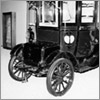

|
|
Electric
Automakers have produced electric cars off and on for
over a century. Ohio-based Baker Motor Vehicle Co. was
among the most successful, selling thousands of its
electrics to wealthy consumers (including Thomas Edison)
from 1899 to 1915. But while each Baker (left, a 1912
model) ran on no fewer than 12 cell batteries, its top
speed was just 14 miles per hour. In contrast, many less
expensive, gas-powered cars could exceed 40 mph. Today,
as gas prices soar and battery technology improves,
all-electric cars might well make a comeback.
|


|
|
Gas-electric hybrid
In 1901, Czech engineer Ferdinand Porsche unveiled the
Mixte (left). French for "mixed," the car was a
forerunner to today's gas-electric hybrids, which use
less gasoline and create fewer emissions than
conventional gas-powered cars. But unlike Porsche's
later sports cars, the Mixte was too far ahead of its
time. The four-seater model required nearly two tons of
batteries, which made it too expensive to be produced in
bulk. (The model seen here is a two-seater.) Improved
battery technologies have helped reduce costs and allow
modern hybrids like Toyota's Prius to sell increasingly
well.
|
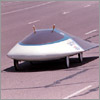

|
|
Solar electric
In 1987, General Motors harnessed solar rays to help run
its Sunraycer experimental racing vehicle (left). The
Sunraycer's photovoltaic cells converted the sun's
energy directly into electrical energy; the electricity
then powered an electric motor that drove the car.
Although similar technology is still used in special
aerodynamic racecars, any purely solar-powered road
vehicle designed to meet general safety standards would
be larger and much heavier than the Sunraycer, requiring
more power than can yet be generated to achieve highway
speeds.
|


|
|
Biofuels
Henry Ford (left, at the wheel of a Model T) designed
his "Tin Lizzie" to run on either gasoline or a
hemp-based fuel. But with the discovery of large
crude-oil deposits in the early 20th century, oil prices
dropped and gasoline derived from the oil became Ford's
and other carmakers' fuel of choice. Unlike fossil
fuels, biofuels come from renewable resources, typically
plants. Although biofuels have many advocates, skeptics
point out that they currently require too many resources
to be used on a widespread commercial basis.
|


|
|
Hydrogen fuel cells
Fuel cells combine fuel (usually hydrogen) and oxygen to
produce electricity through chemical reactions similar
to those that occur in batteries. While some automakers
are now trying to develop hydrogen fuel-cell cars,
General Motors actually designed its own, the
Electrovan, as early as 1966. While the Electrovan
(left) could travel up to 70 mph and 120 miles between
refuelings, it was too expensive to produce
commercially. Recent advances have made affordable fuel
cells more likely, and in 2003 the U.S. Congress pledged
$1.2 billion to make such vehicles cost-effective by
2020.

|
|


We recommend you visit the
interactive version. The text to the left is provided for printing purposes.
|










